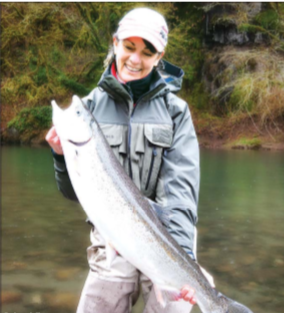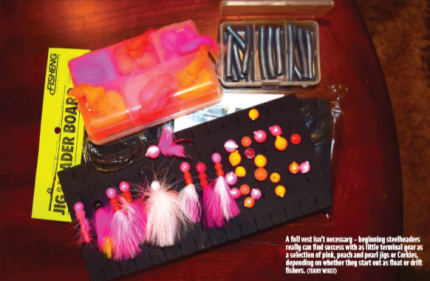
Steelheading On A Budget For Beginners
WIESTSIDER By Terry Wiest
Those who have not had the thrill of a magnificent steelhead on the end of their line simply can’t understand our obsession with winter-runs. We freeze our butts off in the middle of rivers for the chance to catch a fish that many times we will then release! Yes, to some this sounds like we’re nuts. And don’t get me wrong, we kinda are, but experiencing what a steelhead can do to your mind just once converts some of the most hardcore doubters into hardcore anglers, men and women alike.

While many would-be anglers are astonished at how much money we sink into our passion, for beginners it really doesn’t have to be that way. You can always start out simple. Believe me, when you get hooked, you’ll be looking at those $300 rods, $200 reels, $400 waders, $200 boots, etc., but two key things for getting into the sport are actually free – the drive to catch one of the most magnificent fighting fish on the planet, and the patience to endure those times when you don’t find fish. For the beginner, the latter may come quite often, but here’s a true fact: Even for highly experienced and skilled anglers, a skunking is always a possibility, and it’s nothing to be ashamed of. We steelheaders know you have to work for these fish, and maybe that’s why we love them and the sport so much: Catching one is never a given.
But while the motivation costs very little, the basics – rod, reel, line, swivels, hooks, weight, lures – do require a bit of investment. There are two ways we can get started – the traditional drift fishing set-up (my recommendation), and float fishing. Both have their advantages that I’ll discuss below.
DRIFT FISHING
To me, this is the method that every steelheader should start with. The premise of drift fishing outlines the entire gamut of how to fish for steelhead and why they bite. It also gives one an enormous sense of pride having conquered the hardest part of steelheading, detecting the bite. Once you’re relatively successful at drift fishing, all other techniques will just kind of fall into place. Another advantage of drift fishing is the rod. A good drift rod can be utilized for almost all other techniques.
But to get started you’ll probably not want to invest too much money into equipment and gear until you get hooked – just in case you’re one of the few who struggle. I always suggest beginners go with a 9-foot fast-action rod rated 8-12 pounds. Again, this is a rod that can be used for other techniques, and the specs are just suggestions. I started out with an 8½-footer rated 10-17 pounds. Looking back, this was a “killer” rod that I caught many fish on. These days, probably not many people would recommend one with those specs as the ideal steelhead rod, but you utilize what you can afford. There are plenty of options out there for under $100. With drift fishing, “sensitivity” is key. The main difference between a sub-$100 rod and a $300-plus rod is that the material used is lighter, stronger and much more sensitive. Learn to feel a bite on a rod at the lower end of the cost spectrum and just wait until you experience what you feel with a top quality stick, such as the G.Loomis IMX Series!
You’re also going to need a nice reel. I always suggest to purchase the best possible within your budget. A smooth drag will pay dividends in fish caught versus fish breaking off, or coming unbuttoned. A baitcaster is preferred for drift fishing,
Brought and even though some of the spinning reels are super sweet, I’d suggest a nice levelwind reel, hands down. Another suggestion is, if you’re right-handed, use a left-handed reel, and vice versa for left-handers. The reason is that when you cast, you don’t want to switch hands to engage the reel and to retrieve. This way you continue to hold the rod with your dominant hand.
For under $100 the Shimano Caenan 100 or 101 is a pretty sweet low-profile reel with an awesome drag. I’m 100 percent sold on Shimano’s drag technology and swear by them. For slightly over $100 is the Shimano Cardiff 200A or 201A, a round-style reel preferred by most who are just starting out. Many will stay with the round reel, while others will migrate to the low-pro. It’s all about personal preference – me? I use both.
For gear, the beginner can stay pretty simple. Size 10, 12 and 14 Li’l Corkies in pearl pink are sure winners. Other shades of pink and orange are good choices as well, and it’s wise to have some pink yarn. Tie a quality octopus-style hook (Owner, Gamakatsu) in size 4 or 2 via an egg-loop knot to some Ultragreen 10-pound leader behind 10-pound Ultragreen mainline with a 20-pound swivel between them. Pinch some hollow-core lead onto the tag end of the knot for weight, and you are fishing, my friend.
The technique is simple: cast upstream (always) and let your presentation glide down and through the hole. With the leader being about 3 to 4 feet long, allow the weight to “tick” the bottom every few seconds. You do not want it to drag bottom, but not touching bottom is not good either. The periodic tick will let you know you’re in the strike zone, roughly 1 to 2 feet above bottom.
As for the bite, well, that’s something you’ll just have to experience to feel. Many say it’s like sponge sucking your lure in. After years of experience, it becomes instinct, so much so that it’s actually one of the hardest things about fishing to describe.
One of the most well-known drift fishing areas to explore is below the hatchery on the Bogachiel River, just west of Forks. Pay attention to how others there are working the water, especially those who are catching fish. Don’t crowd anyone, but don’t be afraid to ask questions of fellow anglers. Watching others fish for steelhead is second only to experiencing it yourself.
FLOAT FISHING
Now, while float fishing happens to be my favorite technique for steelhead – in fact, I’ve written a book on it (Float Fishing for Salmon and Steelhead; Amato Publications) – I don’t necessarily feel it’s the best for beginning steelheaders. Why? It can be deceptive as to how steelheading should be. You cast a float out with a jig suspended underneath, watch it glide downriver, the float disappears, and boom – you have a fish! Well, it doesn’t always work that way, and to be ultraeffective there are many fine details that will distinguish you as an expert float fisherman. But compared to the skill it takes to detect one while drift fishing, feeling the bite is a no-brainer.
A float fishing rod is a specialty rod, therefore it’s techniquespecific and of not much use for other methods. While I prefer the G.Loomis 1262, unless you know you’re going to love steelheading and float fishing will be your preferred technique, I’d try a less expensive rod first. There are several float rods out there for under $100. Look for a rod that’s between 10 and 10½ feet long and rated 8-12 pounds with moderate action. The 1262 is rated 6-10 pounds, which you’ll appreciate once you have a few fish under your belt.
For a reel, go spinning! While some very good float fishermen still use baitcasters, the majority overwhelmingly employ spinning reels. Again, as with drift fishing, the drag is key and Shimano is the leader of the pack. For $100 get a Symetre 2500FL – this is a super-good reel with an incredible drag for this price point. Now if you want to feel something special, try the Stradic CI4 2500. It’s like butter!
The set-up is simple. Use 30-pound PowerPro main line. Slide a bobber stop, a bead, a 3/8-ounce float and another bead on the mainline. Tie a palomar knot to a ¼-ounce inline weight. Add on a 3-foot leader of 10-pound Seaguar. Attach an 1/8-ounce jig to the leader using a clinch, or reverse clinch knot. And as for terminal offering, overall you can’t go wrong with a pink jig. Anything that’s close to the Beau Mac SMJ #02 and you’re money. You may want to get a few in pinks, whites and peaches, all in the 1/8-ounce size.
For reference, the size of the float is equal to the inline weight plus the weight of the jig, so a ¼-ounce weight plus a 1/8-ounce jig
equals a 3/8-ounce float.
And here you go. Cast your presentation out and let it glide through the holes or slots. You do not want the jig to touch the bottom. Your float will tell you if this is the case by bobbing or going underwater. Adjust the bobber stop by 1-foot increments until you no longer touch the bottom on the drift. You are now in the strike zone. If the float goes down, set the hook!
There’s probably no more famous float fishing water than Reiter Ponds on the Skykomish River. It’s as if Mother Nature created the spot solely with the intention that steelheaders would one day discover the method works really, really well here. Again, watch and talk with other anglers. Watch where they cast, how long their line is from float to jig, etc. This is a popular place to fish and many winter-runs will be caught here this season.
While this tutorial was extremely brief, if you want to know more about float fishing, please read my book. If you want to talk to experts who can set you up within your budget, talk to Gabe Miller at SportCo in Fife and Brian Kim at Outdoor Emporium in Seattle (sportco.com).
“Send them down,” says Miller. “We’ll take care of them and set them up, no matter what their budget.” You don’t need to spend a fortune to get started steelheading, but once you catch that first one, plan on adding to your collection – like the rest of us! NS
